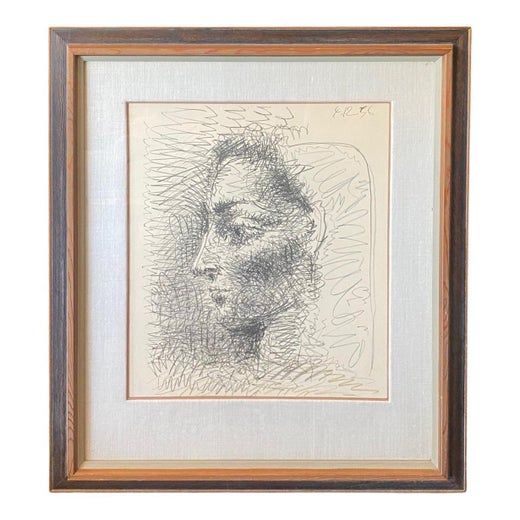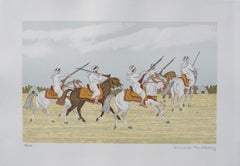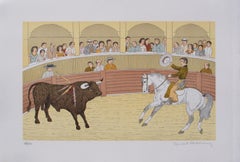Want more images or videos?
Request additional images or videos from the seller
1 of 11
(after) Pablo PicassoDove of Peace - Lithograph
Price:$200.58
$235.97List Price
About the Item
- Creator:(after) Pablo Picasso (1881 - 1973, Spanish)
- Dimensions:Height: 14.97 in (38 cm)Width: 22.05 in (56 cm)Depth: 0.04 in (1 mm)
- Medium:
- Movement & Style:
- Period:
- Condition:
- Gallery Location:Paris, FR
- Reference Number:1stDibs: LU464310750382
(after) Pablo Picasso
Pablo Picasso (1881 – 1973) was a Spanish painter, sculptor, printmaker, ceramicist, stage designer, poet and playwright who is regarded as one of the most influential artists of the 20th century. He is known for co-founding the Cubist movement, the invention of constructed sculpture, the co-invention of collage, and for the wide variety of styles that he helped develop and explore. Exceptionally prolific throughout the course of his long life, Picasso achieved universal renown and immense fortune for his revolutionary artistic accomplishments, and became one of the best-known figures in 20th-century art. The total number of artworks he produced has been estimated at around 50,000.
About the Seller
4.9
Platinum Seller
Premium sellers with a 4.7+ rating and 24-hour response times
Established in 2010
1stDibs seller since 2016
3,764 sales on 1stDibs
Authenticity Guarantee
In the unlikely event there’s an issue with an item’s authenticity, contact us within 1 year for a full refund. DetailsMoney-Back Guarantee
If your item is not as described, is damaged in transit, or does not arrive, contact us within 7 days for a full refund. Details24-Hour Cancellation
You have a 24-hour grace period in which to reconsider your purchase, with no questions asked.Vetted Professional Sellers
Our world-class sellers must adhere to strict standards for service and quality, maintaining the integrity of our listings.Price-Match Guarantee
If you find that a seller listed the same item for a lower price elsewhere, we’ll match it.Trusted Global Delivery
Our best-in-class carrier network provides specialized shipping options worldwide, including custom delivery.You May Also Like
Arciere con cavallo (Archer with horse)
By Giorgio De Chirico
Located in New York, NY
Soft ground etching and aquatint in colours on wove paper
Signed and numbered
Published by Alberto Caprini, Rome
Category
Late 20th Century Modern Animal Prints
Materials
Lithograph
Origiinal FRANCE, Paese dei Casstelli, vintage French travel poster on linen
By Jean Picart Le Doux
Located in Spokane, WA
Original 1950 “France, Paese dei Castelli” Vintage Poster Artist Jean Picart Le Doux Linen-Backed French Castles Travel Art Rare Mid-Century Collectible
Add a touch of French el...
Category
1950s American Modern Landscape Prints
Materials
Lithograph
$975
H 39.5 in W 24.5 in D 0.3 in
HORSE FRIGHTENED BY LIGHTNING - Proof imp - One of Sheet's Most Important Prints
By Millard Sheets
Located in Santa Monica, CA
MILLARD SHEETS (1987 – 1989)
HORSE FRIGHTENED BY LIGHTNING, 1939
Lithograph signed in pencil, annotated “TRIAL PROOF”. The published edition is 75. Image, 17 x 22”. Sheet 19 ½” x 2...
Category
1930s American Modern Landscape Prints
Materials
Lithograph
Le Coq, from Verve Vol VII No. 27-28
By Georges Braque
Located in Washington, DC
Artist: Georges Braque
Title: Le Coq
Portfolio: Verve Vol VII No. 27-28
Medium: Lithograph
Date: 1952
Edition: 6000
Frame Size: 22" x 18 1/4"
Sheet Size: 14" x 10"
Signature: Unsigned
Category
1950s Modern Animal Prints
Materials
Lithograph
Study of Two Classical Greek Horse Heads and a Modern Horse
By Luis Jiménez
Located in Kansas City, MO
Luis Jimenez
Study of Two Classical Greek Horse Heads and a Modern Horse
Year: 1994
2 Color Lithograph
Edition: 28
Paper: Rives BFK, White
Paper Size: 29.5 x 41 inches
Image Size: 16 x 33 inches (irregular)
Signed and numbered by hand
COA provided
---------------
Luis Alfonso Jiménez...
Category
1990s Modern Animal Prints
Materials
Lithograph
$1,555
H 29.5 in W 41 in
Study of a Classical Horse and a Modern Horse
By Luis Jiménez
Located in Kansas City, MO
Luis Jimenez
Study of a Classical Horse and a Modern Horse
Year: 1994
4 Color Lithograph
Edition: 40
Paper: Rives BFK, White
Paper Size: 41.75 x 29.5 inches
Image Size: 37 x 22.75 inches
Signed and numbered by hand
COA provided
---------------
Luis Alfonso Jiménez...
Category
1990s Modern Animal Prints
Materials
Lithograph
"Présure Guillien, Dijon Cow, " Original Color Lithograph Poster by L. Serre
Located in Milwaukee, WI
"Présure Guillien, Dijon Cow" is an original color lithograph poster. The artist's name is printed in the lower left, and the name of the printing company, Havas, is printed in the lower right. The poster advertises rennet, a product used to curdle milk and make cheese, featuring a milk maid with a red kerchief tied around her head in front of a white cow. She holds a golden bucket...
Category
1920s Modern Figurative Prints
Materials
Lithograph
$8,400
H 54.75 in W 39 in
Leonor Fini, from La Grande Parade des Chats, hand signed color lithograph
By Leonor Fini
Located in Chatsworth, CA
Leonor Fini
Untitled from La Grande Parade des Chats (The Great Parade of the Cats)
Color lithograph on Arches paper
Hand signed in pencil by the artist
numbered 204/230
Published b...
Category
1970s Modern Animal Prints
Materials
Lithograph
$620 Sale Price
20% Off
H 12 in W 9.25 in
Original Lithograph Horse Anatomy Leonardo Davinci Nude Male Figure Sepia Signed
By Claude Weisbuch
Located in Milwaukee, WI
"Homage a Leonardo d'Vinci (Leonardo drawing, 3 Figures, Horse from De La Bataille Vol. I)" is an original color lithograph signed by Claude Weisbuch. A group of figures stand to the...
Category
1970s Modern Figurative Prints
Materials
Paper, Lithograph
$7,800
H 27.63 in W 33.88 in
The Passing Parade, 20th Century Lithograph, Southwestern Desert with Antelope
By Ila Mae McAfee
Located in Denver, CO
This stunning original lithograph, titled The Passing Parade, is a signed piece by renowned American artist Ila Mae McAfee (1897-1995). Created in the 20th century, the artwork depic...
Category
20th Century American Modern Animal Prints
Materials
Lithograph
More From This Seller
View AllHorse : Cavalry School - Original Lithograph, HANDSIGNED & Ltd /50
By Vincent Haddelsey
Located in Paris, IDF
Vincent HADDELSEY (1934-2010)
Horse : Cavalry School, 1974
Original Lithograph
Handsigned in pencil
Numbered / 50
On Arches vellum 53 x 38 cm (c. 23 x 15 in)
Excellent condition
Category
1970s Modern Animal Prints
Materials
Lithograph
Horse : Moroccan Riders - Original Lithograph, HANDSIGNED & Ltd /100
By Vincent Haddelsey
Located in Paris, IDF
Vincent HADDELSEY (1934-2010)
Horse : Moroccan Riders, 1974
Original Lithograph
Handsigned in pencil
Numbered / 100
On Arches vellum 53 x 38 cm (c. 23 x 15 in)
Excellent condition
Category
1970s Modern Animal Prints
Materials
Lithograph
Horse : Cavalry School at Saumur - Original Lithograph, HANDSIGNED & Ltd /100
By Vincent Haddelsey
Located in Paris, IDF
Vincent HADDELSEY (1934-2010)
Horse : Cavalry School at Saumur, 1974
Original Lithograph
Handsigned in pencil
Numbered / 50
On Arches vellum 53 x 38 cm (c. 23 x 15 in)
Excellent co...
Category
1970s Modern Animal Prints
Materials
Lithograph
Horse : Bullfighting In Camargue - Original Lithograph, HANDSIGNED & Ltd /100
By Vincent Haddelsey
Located in Paris, IDF
Vincent HADDELSEY (1934-2010)
Horse : Bullfighting In Camargue, 1974
Original Lithograph
Handsigned in pencil
Numbered / 100
On Arches vellum 53 x 38 cm (c. 23 x 15 in)
Excellent c...
Category
1970s Modern Animal Prints
Materials
Lithograph
Horse : The Heel - Original Lithograph, HANDSIGNED & Ltd /100
By Vincent Haddelsey
Located in Paris, IDF
Vincent HADDELSEY (1934-2010)
Horse : The Heel, 1974
Original Lithograph
Handsigned in pencil
Numbered / 100
On Arches vellum 53 x 38 cm (c. 23 x 15 in)
Excellent condition
Category
1970s Modern Animal Prints
Materials
Lithograph
Horse : Polo Game - Original Lithograph, HANDSIGNED & Ltd /100
By Vincent Haddelsey
Located in Paris, IDF
Vincent HADDELSEY (1934-2010)
Horse : Polo Game, 1974
Original Lithograph
Handsigned in pencil
Numbered / 100
On Arches vellum 53 x 38 cm (c. 23 x 15 in)
Excellent condition
Category
1970s Modern Animal Prints
Materials
Lithograph
Recently Viewed
View AllMore Ways To Browse
Pablo Picasso Peace
Pablo Picasso Dove
Picasso Lithograph Peace
Picasso Dove Lithograph
Picasso Print Dove
Picasso Dove Of Peace
Vintage Circus Animals
John Bowen
Sea Bird Art
Antique Crab Print
Camera Lucida
Chris Forrest
Intaglio Bird
Jacques Antiques
White Line Woodcut
Charles Schulz
Etchings Of Horses
Race Horse Print


